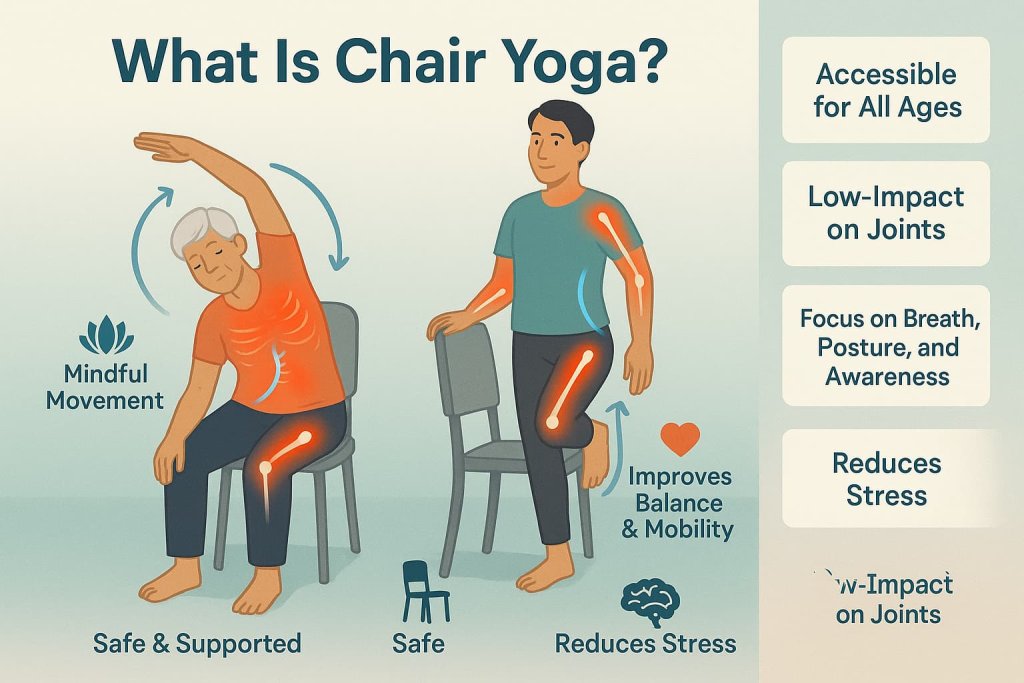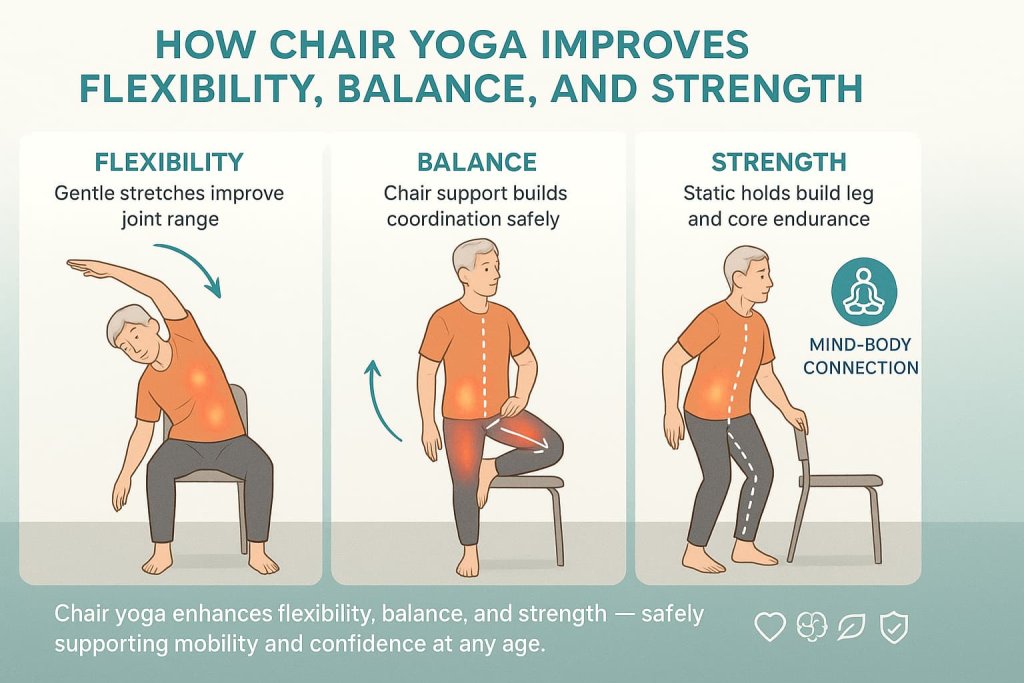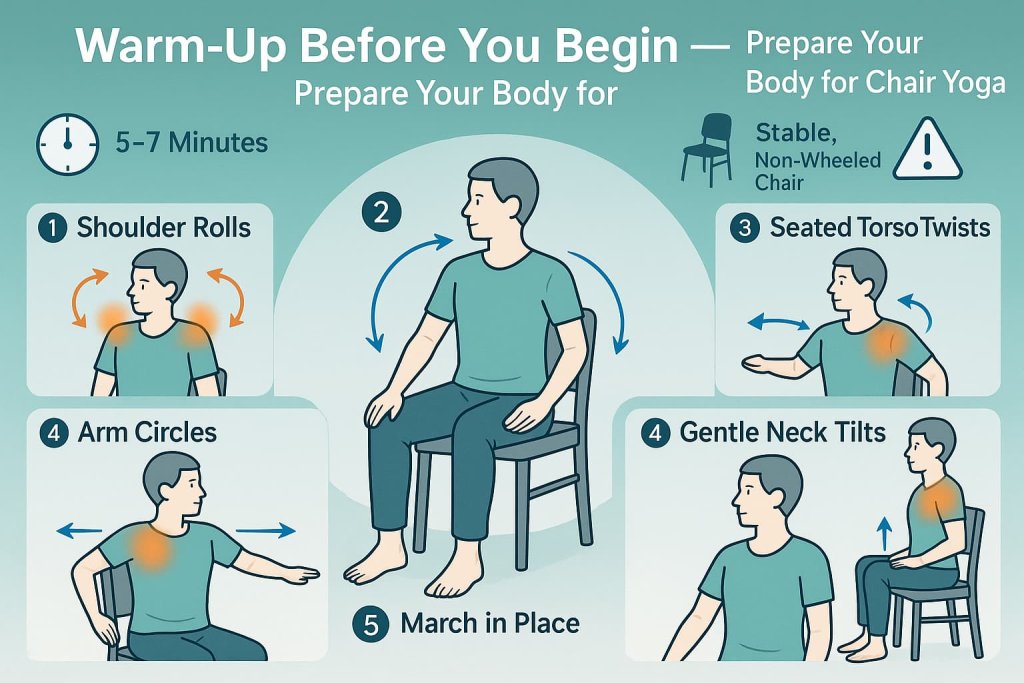Chair yoga is one of the safest and most effective ways to improve flexibility, balance, and strength — even if you have limited mobility, joint pain, or balance issues.
By adapting traditional yoga poses to be performed while seated or using a chair for support, you can enjoy all the benefits of yoga without getting down on the floor.
Chair yoga improves flexibility through gentle movement, builds strength in the core and lower body, and enhances balance for fall prevention — making it ideal for beginners, seniors, or anyone seeking a low-impact routine.
What Is Chair Yoga?

Chair yoga is a modified form of yoga that uses a sturdy chair for seated or standing support. It follows the same principles as traditional yoga — focusing on breath, posture, and mindful movement — but with reduced strain on the joints.
Research from Frontiers in Aging Neuroscience (2024) confirms that chair-based yoga enhances mobility, balance, and strength while lowering stress levels in adults and seniors.
Ideal for:
- Seniors or individuals with balance issues
- People recovering from injury or surgery
- Office workers or those who sit for long hours
- Anyone new to yoga who wants a gentle start
How Chair Yoga Improves Flexibility, Balance, and Strength

Chair yoga matters because it makes movement accessible and safe for everyone — especially seniors, beginners, and those with limited mobility. It combines gentle stretching, light strengthening, and mindful breathing to improve how the body moves and feels.
- Flexibility: Seated and supported poses stretch tight muscles, increase joint mobility, and reduce stiffness in the spine, hips, and shoulders.
- Balance: Using the chair for support allows safe balance practice, improving stability and coordination while reducing fall risk.
- Strength: Holding positions like Sit-to-Stand and Chair Warrior builds endurance in the legs, glutes, and core — muscles essential for daily function.
- Mind–Body Connection: Slow, controlled breathing calms the nervous system, supports focus, and promotes relaxation.
In short, chair yoga safely enhances flexibility, balance, and strength — helping you stay mobile, confident, and active at any age.
Warm-Up Before You Begin

Always warm up for 5–7 minutes before chair yoga to prepare your muscles and joints:
- Shoulder rolls – 10 forward and 10 backward
- Arm circles – 10 each direction
- Seated torso twists – 5 each side
- Gentle neck tilts – 5 each direction
- March in place (seated or standing) – 1 minute
Tip: Use a sturdy, non-wheeled chair placed on a flat, non-slip surface.
The 15 Best Chair Yoga Exercises
These 15 chair yoga exercises combine gentle stretching, mindful breathing, and light strengthening to support flexibility, balance, and joint health — all from the safety of a chair.
Practiced regularly, they help you move with more ease, improve posture, and build confidence in daily activities.
1. Seated Mountain Pose (Tadasana)
Why it works:
Encourages correct posture, engages the deep core stabilizers, and improves breath control. This pose resets spinal alignment and promotes awareness of body positioning.
Muscles worked:
Transverse abdominis, erector spinae, trapezius, rhomboids, and diaphragm.
How to do it:
- Sit upright with your feet flat on the floor, knees hip-width apart.
- Stack shoulders over hips, lengthen your spine, and relax shoulders.
- Place palms on your thighs or at your sides.
- Inhale deeply through the nose, lengthening the crown of your head upward.
- Exhale slowly while maintaining tall posture.
Trainer Tip:
Think of growing taller with each inhale — avoid collapsing through the chest or rounding the back.
2. Seated Cat–Cow Stretch
Why it works:
Improves spinal mobility and releases stiffness in the back and shoulders. It also promotes coordination of movement with breath.
Muscles worked:
Erector spinae, rectus abdominis, and rhomboids.
How to do it:
- Sit tall with hands resting on knees.
- Inhale, arch your back, lift your chest, and look slightly upward (Cow).
- Exhale, round your spine, and tuck your chin toward your chest (Cat).
- Repeat slowly for 8–10 cycles.
Trainer Tip:
Move fluidly with your breath—avoid forcing range or dropping the head too far back.
3. Seated Side Bend
Why it works:
Enhances lateral flexibility and releases tension in the sides of the torso, promoting balanced spinal mobility.
Muscles worked:
Obliques, latissimus dorsi, intercostals, and quadratus lumborum.
How to do it:
- Sit tall with feet grounded.
- Place one hand on the chair seat and raise the opposite arm overhead.
- Inhale to lengthen upward; exhale to lean gently to the side.
- Keep both sit bones anchored.
Trainer Tip:
Reach up before you lean — this maintains length through the spine and prevents collapse.
4. Seated Spinal Twist
Why it works:
Increases rotational mobility, improves spinal health, and aids digestion through gentle compression and release.
Muscles worked:
Obliques, multifidus, erector spinae, and rectus abdominis.
How to do it:
- Sit tall and place your right hand on the backrest, left hand on your thigh.
- Inhale to lengthen the spine; exhale and gently rotate from the mid-back.
- Hold for 3–5 breaths, then repeat on the other side.
Trainer Tip:
Initiate the twist from your ribs, not your neck — keep the chin relaxed.
5. Seated Forward Fold
Why it works:
Stretches the hamstrings and lower back, promotes spinal decompression, and calms the nervous system.
Muscles worked:
Hamstrings, gluteus maximus, erector spinae.
How to do it:
- Sit with feet flat, slightly forward from the chair.
- Exhale and hinge forward from the hips, letting arms and head hang naturally.
- Keep knees soft and spine long.
Trainer Tip:
Lead the movement with your chest, not your head, to protect your lower back.
6. Seated Figure-4 Stretch (Pigeon Pose)
Why it works:
Opens tight hips and glutes, reduces lower-back tension, and improves pelvic mobility.
Muscles worked:
Gluteus medius, piriformis, and hip external rotators.
How to do it:
- Cross your right ankle over your left thigh, keeping the foot flexed.
- Sit tall, then gently press your right knee downward.
- Hold for 5–8 breaths, then switch sides.
Trainer Tip:
Avoid rounding your spine — lift through your chest and hinge from the hips.
7. Seated Hamstring Stretch
Why it works:
Enhances flexibility in the back of the legs and improves lower-body mobility for walking and balance.
Muscles worked:
Hamstrings, gastrocnemius, and erector spinae.
How to do it:
- Extend one leg straight out with heel on the floor, toes pointing up.
- Keep your spine tall and hinge forward slightly until a mild stretch is felt.
- Hold for 20–30 seconds per leg.
Trainer Tip:
Keep your back flat — avoid rounding forward to reach your toes.
8. Seated Knee Lift
Why it works:
Strengthens hip flexors and core stabilizers, promoting better gait and leg control.
Muscles worked:
Iliopsoas, rectus femoris, and lower abdominals.
How to do it:
- Sit tall, hands on the sides of the chair.
- Lift one knee toward your chest, pause briefly, then lower.
- Alternate legs for 10–12 repetitions.
Trainer Tip:
Engage your core before lifting — control each movement slowly and deliberately.
9. Seated Cactus Arms (Goalpost Pose)
Why it works:
Opens the chest, strengthens postural muscles, and counteracts rounded-shoulder posture from sitting.
Muscles worked:
Rhomboids, posterior deltoids, trapezius, and pectoralis minor.
How to do it:
- Sit tall with arms raised to shoulder height, elbows bent at 90°.
- Inhale, open your chest and squeeze shoulder blades together.
- Exhale, return to start. Repeat for 8–10 slow reps.
Trainer Tip:
Avoid arching the lower back—keep ribs drawn down and spine neutral.
10. Seated Sun Salutation Flow
Why it works:
Combines breath, mobility, and flow to warm the body, improve circulation, and enhance focus.
Muscles worked:
Deltoids, erector spinae, quadriceps, and abdominals.
How to do it:
- Inhale, raise arms overhead.
- Exhale, fold forward to your thighs.
- Inhale, lift back to upright.
- Exhale, bring hands to heart center.
- Repeat 5–6 slow cycles.
Trainer Tip:
Link every motion to breath — smooth transitions improve coordination and calm the mind.
11. Chair-Supported Tree Pose
Why it works:
Develops single-leg balance, ankle stability, and hip control, reducing fall risk.
Muscles worked:
Gluteus medius, quadriceps, ankle stabilizers, and core.
How to do it:
- Stand beside a chair, one hand on the backrest.
- Place the sole of one foot on the opposite calf or ankle.
- Press the standing leg firmly into the ground.
- Hold for 15–30 seconds, then switch sides.
Trainer Tip:
Gaze at a fixed point ahead to improve steadiness (this is called your “drishti”).
12. Chair-Supported Warrior II
Why it works:
Builds leg strength, hip flexibility, and endurance while enhancing focus and coordination.
Muscles worked:
Quadriceps, gluteus medius, hamstrings, and deltoids.
How to do it:
- Hold the backrest with one hand and step feet wide apart.
- Turn your front foot forward, back foot slightly in.
- Bend the front knee to align above the ankle.
- Extend both arms parallel to the floor.
Trainer Tip:
Engage both thighs and keep shoulders stacked over hips.
13. Chair-Supported High Lunge
Why it works:
Improves lower-body strength, stretches hip flexors, and supports upright posture.
Muscles worked:
Gluteus maximus, quadriceps, hip flexors, and calves.
How to do it:
- Hold the chair’s backrest for support.
- Step one leg back, keeping front knee bent at 90°.
- Keep chest lifted and engage glutes.
- Hold for 5 breaths, then switch legs.
Trainer Tip:
Squeeze your back glute gently to protect the lower back.
14. Heel-to-Toe Walk (Chair Support)
Why it works:
Enhances coordination, balance, and proprioception (awareness of body position).
Muscles worked:
Tibialis anterior, gastrocnemius, and peroneals.
How to do it:
- Stand beside a chair for support.
- Walk slowly in a straight line, placing the heel of one foot directly in front of the toes of the other.
- Take 8–10 controlled steps, then turn and repeat.
Trainer Tip:
Keep your gaze forward and shoulders relaxed; avoid looking down excessively.
Programming Tips & Progression Guidelines
- Beginners: 1 round (15–20 minutes, 2–3x weekly)
- Intermediate: 2–3 rounds (25–30 minutes, 3–4x weekly)
- Breathing: Inhale during expansion, exhale during effort
- Progression: Increase hold time or add resistance bands for strength
Safety and Precautions
- Use a stable, non-rolling chair on a flat surface.
- Move within a comfortable, pain-free range.
- Stop immediately if you feel dizziness, pain, or shortness of breath.
- Keep hydration nearby.
- Consult your physician before starting if you have chronic conditions or balance issues.
According to the National Institute on Aging, older adults should aim for at least 150 minutes of moderate activity weekly, and chair yoga fits safely within this guideline.
FAQs
1. Can beginners do chair yoga?
Yes. Chair yoga is beginner-friendly and safe for all ages, including seniors.
2. How often should I practice chair yoga?
2–4 sessions per week provide measurable flexibility and balance improvements.
3. Do I need yoga experience?
No — all poses are adapted for safety and can be performed at home with minimal space.
4. Can chair yoga help with arthritis pain?
Yes. Studies show reduced stiffness and pain in participants with knee and hip arthritis.
5. What kind of chair should I use?
Use a stable, straight-backed, non-rolling chair without armrests for full range of motion.
6. Does chair yoga build strength?
Yes. Supported poses activate the core, legs, and shoulders while improving endurance.
7. Is chair yoga safe for seniors?
Absolutely — it’s one of the most recommended low-impact forms of movement for older adults.
Conclusion
Chair yoga makes flexibility, balance, and strength training accessible to everyone — no mat, floor work, or advanced flexibility required. By practicing these 15 poses regularly, you’ll gain mobility, improve posture, and feel more confident in everyday movement.
Start today — all you need is a chair and 15 minutes.
References
- Park J. et al. (2017). A Pilot Randomized Controlled Trial of the Effects of Chair Yoga on Pain and Physical Function Among Community-Dwelling Older Adults With Lower Extremity Osteoarthritis. Journal of the American Geriatrics Society
- NHS (n.d.). Sitting exercises. nhs.uk
- National Institute on Aging (NIH) (2025). Exercise and physical activity — older adults. National Institute on Aging
- Zhang S. et al. (2025). Effects of different exercise modalities on balance performance in healthy older adults: a systematic review and network meta-analysis. BMC Geriatrics
- Lohmann L.H. et al. (2024). Acute and chronic effects of stretching on balance: a systematic review with multilevel meta-analysis. Frontiers in Medicine (PMC)
- Tew G. et al. (2024). Effectiveness and cost-effectiveness of offering a chair-based yoga programme in addition to usual care for older adults with multimorbidity: Randomised controlled trial. PubMed
